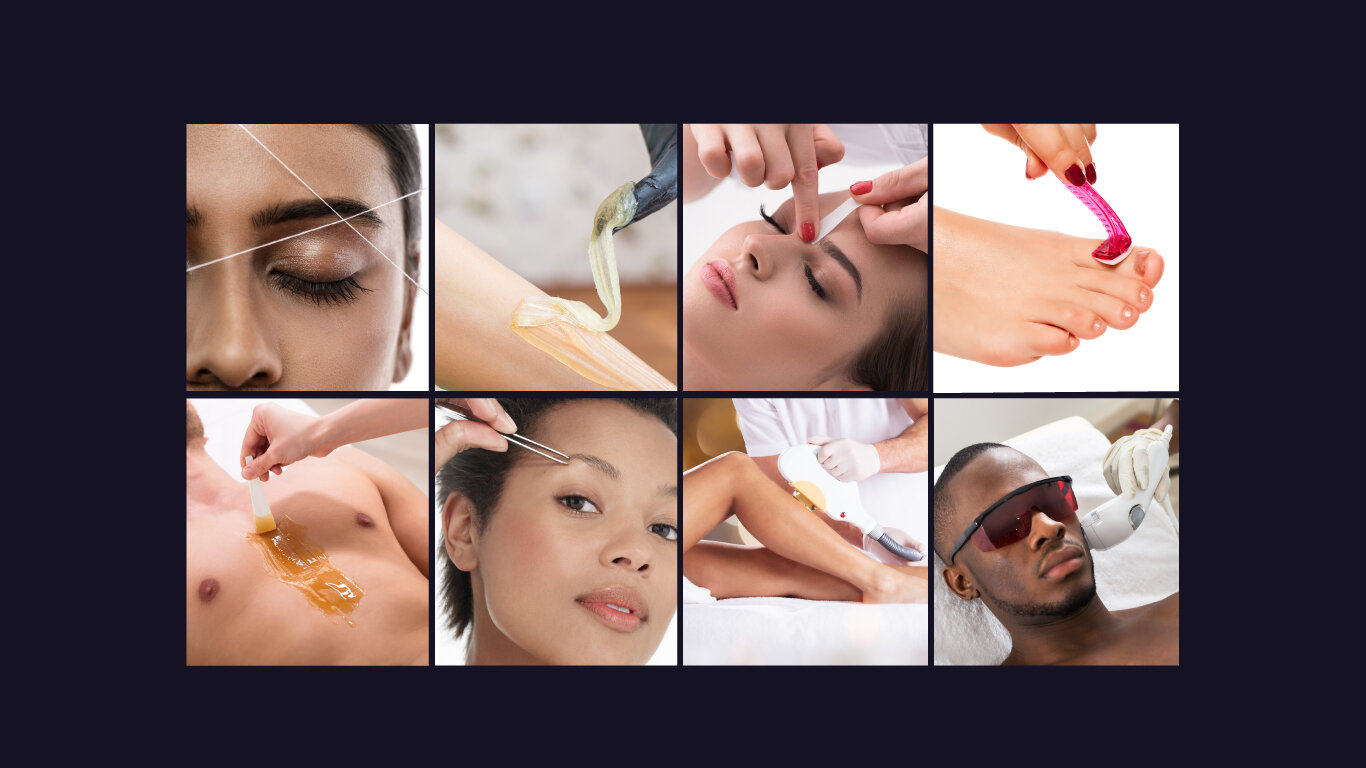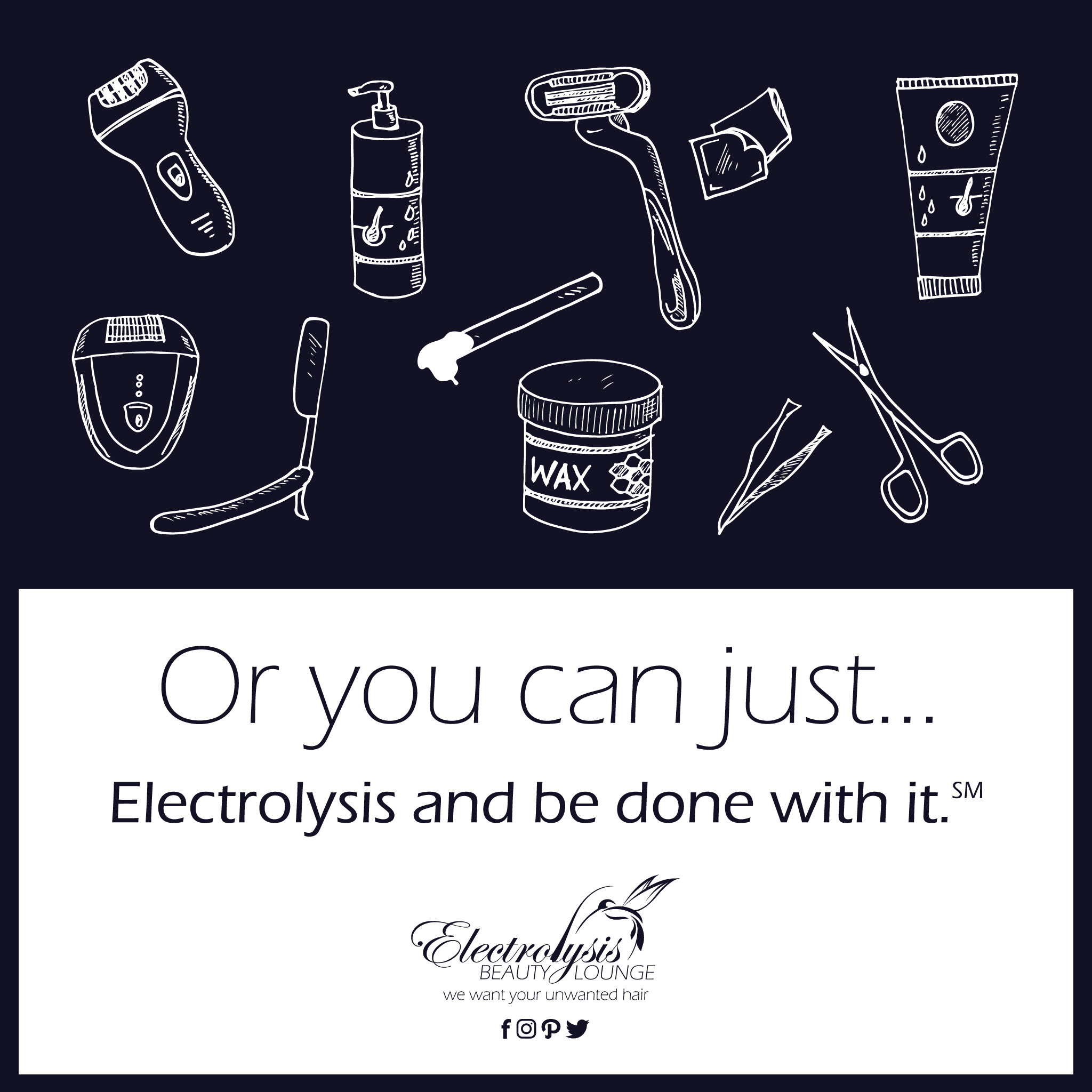WHAT ABOUT OTHER REMOVAL METHODS?
Did You Know…
Other hair removal professionals are legally forbidden to claim their method provides permanent results? That’s right! They are only allowed to promise permanent hair reduction. Electrolysis is still the only method approved by the FDA as a permanent hair removal solution.
That’s not to say other methods can’t play a role in helping to achieve some of your desired results; in fact, in some cases, they even complement electrolysis.
MOST FREQUENTLY USED
Lasering - Hair removal lasers beam pulses of light into the hair follicle attempting to destroy it. Its success rate relies on the amount of pigment in the hair as well as the amount of contrast between the hair and the skin. This procedure is restricted in most states to only being administered by a medically licensed professional because of its potential risks including paradoxical hypertrichosis ».
Laser hair removal is NOT FDA approved as a permanent hair removal method, nor is it covered by insurance for gender change procedures.
Waxing - Waxing, a form of epilating, is the process of hair removal from the root by adhering wax to body hair, and then removing this covering taking the hair from the follicle along with it.
Strip waxing, (soft wax) is accomplished by spreading wax thinly over the skin. A cloth or paper strip is applied, pressed firmly, and then quickly ripped against the direction of hair growth.
Stripless wax, (hard wax) is also applied directly to the skin. The wax then hardens when it cools, allowing an esthetician to easily remove it without the aid of strips. This method is beneficial for those with sensitive skin.
Sugaring - Also known as Persian waxing, sugaring has been around since 1900 B.C. but has significantly increased in popularity in the last few years because it’s a natural alternative to modern waxing. Its most basic ingredients include sugar, honey, lemon juice and water, making it water-soluble and absent of harmful chemicals. Sugaring, also a form of epilating, compares closest to stripless-waxing in the way it’s applied to the skin and in the results achieved when done by a trained esthetician.
Shaving - Shaving, or clipping, is the removal of hair using a razor or any other bladed instrument to slice hair at the level of the skin. Moisturizers that contain vitamin E have helped some women shave less frequently.
Tweezing - Tweezing, yet another form of epilating, is the removal or pluck of the hair from the follicle, usually one at a time, using a pair of handheld tweezers. Like threading, tweezing allows for better precision over waxing and over sugaring.
Threading - Threading, another form of epilating, is a method of hair removal originating in Iran, India, Central Asia and China and has become most popularly used in Western countries for trimming and shaping the eyebrows.
During threading, a thin cotton or polyester thread is doubled, twisted, then rolled over areas of unwanted hair, plucking the hair at the follicle level. Unlike tweezing, where single hairs are pulled out one at a time, threading can remove short rows of hair, and it provides more precise control in shaping eyebrows. Threading is gentler on the skin than waxing.
There are a few different techniques for threading, including the hand method, mouth method and neck method but the mouth-holding method is the fastest and most precise.
Epilating - An epilator is a handheld device with a rotating roller that, when glided over the skin, removes unwanted hair like a bunch of tweezers all working at once.
Epilating is a term that refers to any hair removal that rips multiple hairs at once from the follicle, not just an electronic epilator. Sugaring, waxing, threading & tweezing are also forms of epilation; however, when referring to epilating, most people are referencing the use of an electronic epilator. Epilating is the best alternative to sugaring and waxing for people with overly-sensitive skin.
Depilatory Creams - A depilatory is a chemical composition used to remove hair by breaking down its protein bonds. It comes in several forms like gel, powder, and even roll-on sprays; however, the most popular are in the lotion & creams category. Depilatory creams take up to 15 minutes to work once applied depending on the thickness and density of the hair being treated. Once complete, the product can be wiped off with a cloth.
COMPARE + CONTRAST + COMPLEMENT
We know it's hard to decide which hair removal method is best for you. To make it a little easier, we took the most frequently used methods and provided information about how long its results last, cost, advantages, obstacles, recommendations on who should and should not use them, the pain factor, and what other method(s) it compares to in terms of what happens either on or beneath the surface of the skin.*
Finally, we’ve also included which ones can be paired together to complement your desired results without jeopardizing the integrity of the other.
+ Laser
LASTS: 6-12 months
PRICE: $$$$$
ADVANTAGES: Fast treatment time; Long-lasting results; Regrowth is often finer and lighter; Safe for most body parts
DISADVANTAGES: Can stimulate "peach fuzz" to grow into thicker, darker hairs; Some people are deemed non-candidates because of hair and skin type; Known to be painful; Hair eventually grows back; Distorts follicles causing ingrowns upon regrowth, Expensive treatments; imprecise; Can cause redness and swelling immediately after treatment; Gives a false sense of permanence because it is long lasting; Cannot be used over tattoos because it will burn the skin
RECOMMENDED FOR: People with dark hair and fair skin (high contrast)
NOT RECOMMENED FOR: The face because it can stimulate vellus hair (peach fuzz) to grow; People with gray, red or blonde hair; People with dark skin. This is called paradoxical hypertrichosis »
PAIN FACTOR: HIGH - feels like a bunch of rubber bands snapping against the skin. The thinner the skin and closer to the center line of the body, the more painful it is. Women also tend to experience more pain when they are menstruating.
COMPARES TO: In technique: None; In results = None; In Price: None
COMPLEMENTS ELECTROLYSIS: NEVER!
OTHER COMMENTS: Success rate relies on the amount of pigment in the hair as well as the amount of contrast between the hair and the skin. Therefore, people with gray, red, blonde hair and those with dark skin are deemed non-candidates. Laser can be very effective for those who are deemed candidates but it is imprecise enough to destroy all hairs so many clients visit an electrologist following laser treatments to permanently remove stray hairs. Beware of untrained technicians when getting treatments because it can leave serious and permanent scars. Clients should do a test patch before committing to larger areas of hair removal and, in some cases, consult their doctor before trying laser treatments.
* Most common types of laser »
+ Waxing
LASTS: 2-3 weeks
PRICE: $$ - this rating is for individual treatments. Since waxing does not provide permanent results, clients will spend thousands of dollars over the course of their lifetime if they continue to get hair removal from a professional.
ADVANTAGES: Can be done at home; Fast treatment time, Single treatments are relatively inexpensive; Safe for all body parts
DISADVANTAGES: Known to be painful; Hair eventually grows back; Distorts follicles causing ingrowns upon regrowth, imprecise (tweezers needed to complement); Messy; Can cause slight redness and swelling immediately after treatment
RECOMMENDED FOR: Anyone not getting electrolysis
NOT RECOMMENED FOR: Those with sensitive skin; Clients also getting electrolysis
PAIN FACTOR: MEDIUM - The thinner the skin and closer to the center line of your body, the more painful it is. Women also tend to experience more pain when they are menstruating.
COMPARES TO: In technique: Sugaring; In results: Sugaring, threading, epilating & tweezing; In Price: Sugaring
COMPLEMENTS ELECTROLYSIS: NEVER!
OTHER COMMENTS: People with sensitive skin find they have better experience with sugaring because of its natural ingredients.
+ Sugaring
LASTS: 1-3 weeks
PRICE: $$ - this rating is for individual treatments. Since sugaring does not provide permanent results, clients will spend thousands of dollars over the course of their lifetime if they continue to get hair removal from a professional.
ADVANTAGES: Fast treatment time; Single treatments are relatively inexpensive; Safe for all body parts; Uses natural ingredients; Great for people with sensitive skin; Can be done at home
DISADVANTAGES: Known to be painful (although less so than waxing); Hair eventually grows back; Distorts follicles causing ingrowns upon regrowth, imprecise (tweezers needed to complement); Messy but less so than waxing; Can cause slight redness and swelling immediately after treatment
RECOMMENDED FOR: Anyone not getting electrolysis
NOT RECOMMENED FOR: People with overly-sensitive skin; Clients also getting electrolysis
PAIN FACTOR: MEDIUM - The thinner the skin and closer to the center line of your body, the more painful it is. Women also tend to experience more pain when they are menstruating.
COMPARES TO: In technique: Waxing; In results: Waxing, threading, epilating & tweezing; In Price: Waxing
COMPLEMENTS ELECTROLYSIS: NEVER!
OTHER COMMENTS: People with sensitive skin find they have better experience with sugaring because of its natural ingredients.
+ Shaving (Clipping)
LASTS: 1-3 days
PRICE: $
ADVANTAGES: Can be done at home; Fast treatment time; Inexpensive; Safe for all body parts; Painless if done correctly
DISADVANTAGES: Fast regrowth because shaving only removes hair above the surface of the skin; Leads to ingrowns, especially for those with curly hair; Needs a shaving gel or cream to prevent damaging the skin; May not be good for people with sensitive skin; Sharp blade can slice skin if not done correctly
RECOMMENDED FOR: Anyone
NOT RECOMMENED FOR: Those with sensitive skin and curly hair; People looking for long-lasting results
PAIN FACTOR: LOW
COMPARES TO: In technique: None; In results: Depilatory creams, In Price: Tweezing, epilating & depilatory creams
COMPLEMENTS ELECTROLYSIS: Yes - Shaving, like depilatory creams, is recommended between treatments if grooming is necessary.
OTHER COMMENTS: It's important to change blades frequently to avoid infection. People with sensitive skin should consider using a shaving cream and after-shaving moisturizer containing Aloe and or Vitamin E.
+ Tweezing
LASTS: 1-3 weeks
PRICE: $
ADVANTAGES: Precise; Can be done anywhere; Inexpensive; Never messy; Complements sugaring, waxing, threading & lasering because tweezing can get finer stray hairs
DISADVANTAGES: Known to be uncomfortable; Hair eventually grows back; Distorts follicles causing ingrowns upon regrowth; Can cause slight redness and swelling immediately after treatment; Slow process; If tweezer edges are too sharp, they can cut the hair making it impossible to grasp again and remove it from the follicle as originally intended
RECOMMENDED FOR: Anyone not getting electrolysis; Small areas with few hairs
NOT RECOMMENED FOR: Clients also getting electrolysis; Large, dense areas
PAIN FACTOR: LOW
COMPARES TO: In technique: None; In results: Waxing, sugaring threading & epilating; In Price: Shaving, electronic epilating & depilatory creams
COMPLEMENTS ELECTROLYSIS: NEVER!
OTHER COMMENTS: A pair of high-end tweezers can cost around $20-$30. Tweezers should never be used to dig out ingrown hairs. Instead try using a lancet and then allow the skin to completely heal before tweezing the hair. Tweezers can be sharpened using a metal file, but it's recommended to replace them after several time sharpening.
+ Threading
LASTS: 1-3 weeks
PRICE: $
ADVANTAGES: Precise; Fast treatment time; Single treatments are relatively inexpensive; Safe for all body parts; Not messy; Better option for people who can't put wax on their face
DISADVANTAGES: Known to be uncomfortable; Hair eventually grows back; Distorts follicles causing ingrowns upon regrowth; Can cause slight redness and swelling immediately after treatment
RECOMMENDED FOR: Anyone not getting electrolysis
NOT RECOMMENED FOR: Clients also getting electrolysis
PAIN FACTOR: LOW - If done correctly
COMPARES TO: In technique: None; In results: Waxing, sugaring tweezing & epilating; In Price: Waxing & sugaring
COMPLEMENTS ELECTROLYSIS: NEVER!
OTHER COMMENTS: There are a few different techniques for threading including the hand method, mouth method and neck method. Each technique has advantages and disadvantages; however, the mouth-holding method is the fastest and most precise.
+ Epilating
LASTS: 1-3 weeks
PRICE: $$
ADVANTAGES: Can be done at home; Fast treatment time; Inexpensive; Easy; Safe for all body parts; Not Messy; Can address large, dense areas
DISADVANTAGES: Hair eventually grows back; Distorts follicles causing ingrowns upon regrowth; imprecise (tweezers needed to complement); Can cause slight redness and swelling immediately after treatment
RECOMMENDED FOR: Anyone not getting electrolysis
NOT RECOMMENED FOR: Clients also getting electrolysis
PAIN FACTOR: LOW-MEDIUM - The speed can be slowed for more sensitive skin but remember slower settings will increase the amount of time it takes to clear the area.
COMPARES TO: In technique: None; In results: Waxing, sugaring tweezing & threading; In Price: Tweezing, shaving, clipping and depilatory creams
COMPLEMENTS ELECTROLYSIS: NEVER!
OTHER COMMENTS: Epilators can be used in the shower and don't require replacement as frequently as razors/bladed tools
+ Depilatory Creams
LASTS: 1-3 days
PRICE: $
ADVANTAGES: Can be done at home; Fast treatment time; Inexpensive per single use; Easy; Can be used between electrolysis treatments
DISADVANTAGES: Fast regrowth because like shaving, it only removes hair above the surface of the skin; May not be good for people with sensitive skin; Messy; Unpleasant odor
RECOMMENDED FOR: Anyone who does not have sensitive skin.
NOT RECOMMENED FOR: People with sensitive skin; Those looking for long-lasting results
PAIN FACTOR: LOW - slight discomfort from a tingling effect can be expected.
COMPARES TO: In technique: None; In results: Shaving and clipping; In Price: Shaving, clipping, tweezing and epilating
COMPLEMENTS ELECTROLYSIS: Yes - Depilatory creams, like shaving, are recommended between treatments if grooming is necessary.
OTHER COMMENTS: If a burning sensation is experienced, the cream has either been left on too long or you could be allergic.
+ Electrolysis
LASTS: Forever!
PRICE: $$$$ - until treatment plan is complete but there's no lifetime commitment necessary making this option cheaper than lasering, waxing, sugaring, threading in the long-run.
ADVANTAGES: Results last forever once treatment plan is complete; Precise; Multiple modalities available to manage pain factors; Complements lasering because of precision
DISADVANTAGES: Can't be done at home; Costly until hair is completely gone; Takes multiple sessions before real results are noticed; Can cause slight redness and swelling immediately after treatment
RECOMMENDED FOR: Anyone looking to remove unwanted hair forever; Anyone getting laser but still has hair over their tattoos
NOT RECOMMENED FOR: Women who are pregnant; People who Keloid, or have healing or clotting issues without a doctor's approval
PAIN FACTOR: MEDIUM to HIGH - There are three (3) different modalities in electrolysis and most find that one is significantly less painful over another. Work with your electrologist to find your ideal working point.
COMPARES TO: In technique: None; In results: None; In Price: None because it does not require a life-long commitment.
COMPLEMENTS ELECTROLYSIS: Of Course!!
OTHER COMMENTS: Some compare the price of electrolysis to laser, but this only applies for the length of the treatment plan. The need for laser treatments on the body will decrease at a decreasing rate but hair can eventually grow back even for the perfect laser candidate so laser clients will technically never stop paying for removal. Also remember, due to the lack of its preision, there will always be hair that the laser misses so some other form of epilation is necessary to remove stray hairs.
* Information provided is based on an average. Remember, everyone’s hair growth rate and pain threshold is unique and prices vary among service providers.
“Make your choices reflect your hopes, not your fears.”



